Industry analysts agree that data fabrics are key to data and analytics transformation. Enterprises need quick and efficient access to data assets, whether on premises or in the cloud. And as a growing number of data consumers need on-demand access to relevant data, being able to deliver the right data becomes critical.
See how data fabric unifies data for your use case
A data fabric can integrate and connect all your organization’s data. It removes the complexities of data storage and streamlines delivery. A data fabric is also able to manage large volumes of structured, unstructured or semi-structured data. This makes it ideal for reducing risk, increasing collaboration and improving business outcomes. When you add up the benefits of automating data-driven insights, the potential ROI around data fabric can be significant.
What is data fabric?
A data fabric is a set of services and architecture that deliver reliable capabilities across data environments. The architectural aspects of data fabric require standardization of data practices across data storage platforms and devices. In their recent report, The Forrester Wave™: Enterprise Data Fabric, Q2 2022, Forrester does not define the term so much as it explains what a data fabric does: “Data fabric delivers a unified, integrated, and intelligent end-to-end data platform to support new and emerging use cases. It automates all data management functions — including ingestion, transformation, orchestration, governance, security, preparation, quality and curation — enabling insights and analytics to accelerate use cases quickly.”1
Why do you need a data fabric?
Modern data management is complex. New technologies, new kinds of data and new platforms are being added all the time. And it’s not easy to change and bolster data management methods with each shift in technology. As technology innovation speeds up, traditional approaches to data management become unsustainable.
A data fabric can help you address rapid changes in technology and minimize disruption. The adaptable nature of data fabric can help you create a data management strategy with augmented data integration.
A data fabric is agnostic and works on different deployment platforms and with all kinds of data processing methods. It facilitates the use of data as a strategic asset by abstracting complexity. And with a data fabric, you can combine, access, share and govern any data on any platform from any location.
Data fabric benefits
A data fabric reduces costs and increases productivity, with faster time to value:
- Makes trusted data accessible faster, limiting data silos and accelerating self-service data discovery and analytics.
- Automates data engineering tasks and augments data integration to deliver real-time insights.
- Leverages active metadata to improve data quality, data curation, data classification, policy enforcement and more
- Helps you prepare your jobs for any environment and any data volume with automated workload orchestration.
- Allows consumers to find, understand and trust data with automated data discovery and enrichment.
Five key pillars of a data fabric
Informatica Intelligent Data Fabric is a hybrid, multi-cloud data fabric. It enables autonomous data management and delivers trusted data for your AI initiatives.
1. Augmented data catalog. The AI-powered, Intelligent Data Catalog allows you to find, understand and prepare data.
- Provides comprehensive metadata connectivity for all enterprise data.
- Enables automatic discovery, automates data lineage and classifies and contextualizes data assets.
- Facilitates collaboration and curation to tap into shared data knowledge from the community.
- Delivers data asset analytics to understand, measure and improve data value.
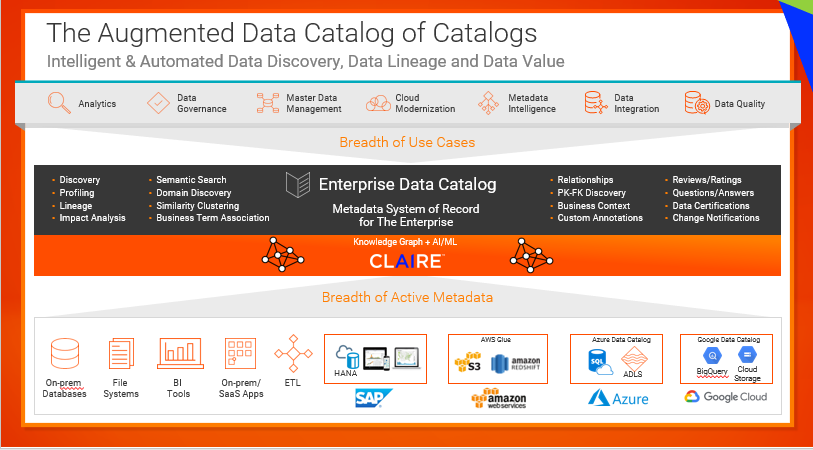
2. Knowledge graph enriched with semantics. Enterprise Knowledge Graph, part of the CLAIRE AI engine, puts data in context. It links and enriches semantic metadata to deliver artificial intelligence (AI) and machine learning (ML) to data management functions:
- Creates greater understanding of your data assets and data models.
- Allows exploration of networks and relationships to uncover value of new connections between data.
- Enables holistic enterprise views, data sharing and self-service with auto-generated, cross-departmental knowledge graph.
- Reduces regulatory and compliance risk by automatically linking to sensitive data.
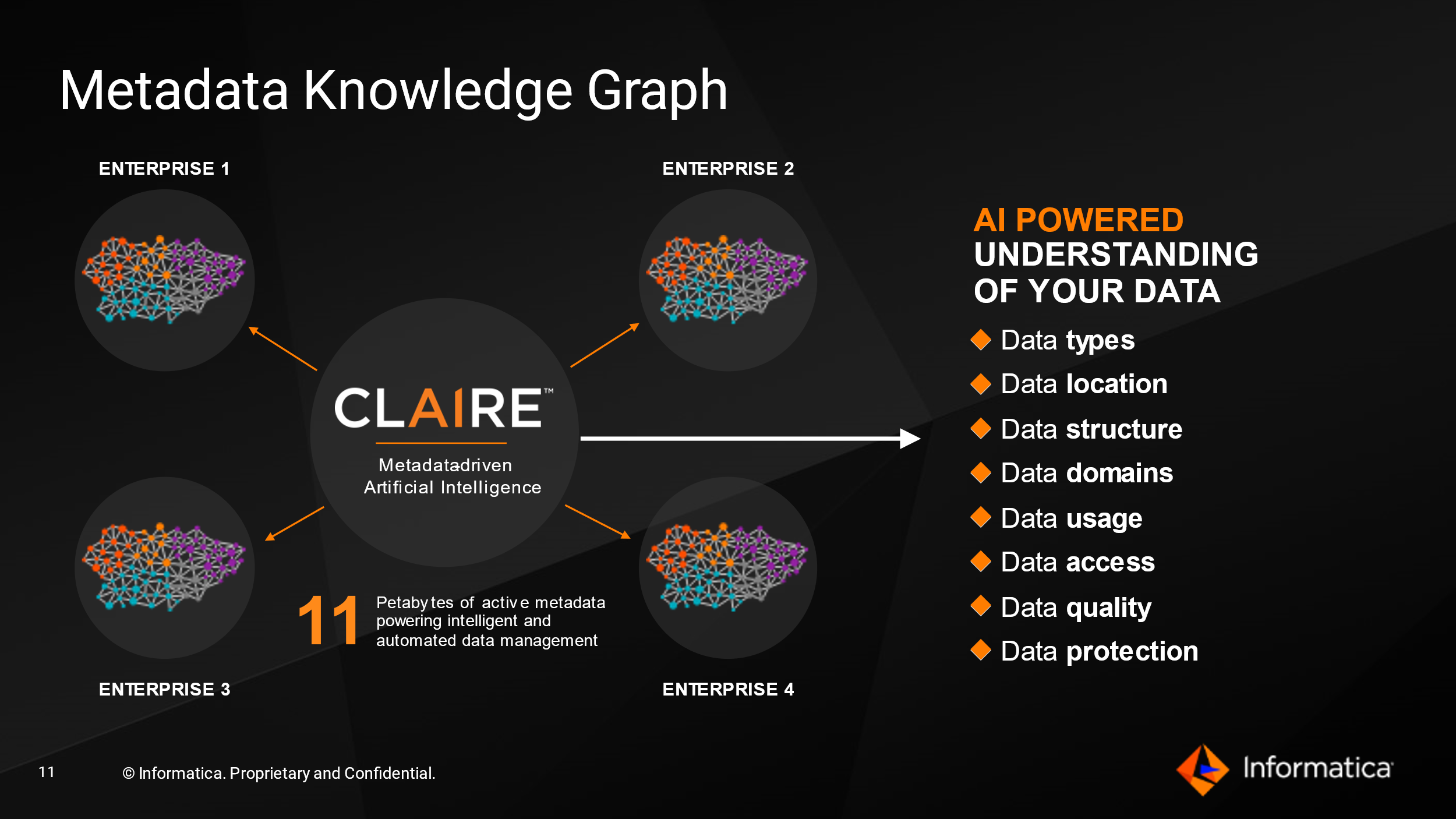
3. Metadata activation and recommendation engine. The CLAIRE engine learns your data landscape, allowing you to automate thousands of manual tasks. Use recommendations and insights to augment human activity and scale your data management to meet your business’s needs.
- Enables comprehensive, unified metadata foundation with more than 50,000+ metadata-aware scanners.
- Delivers AI/ML automation for all data management functions such as integration, data quality, governance and master data management.
- Provides intelligent recommendations like next-best transformation, data quality rules and more.
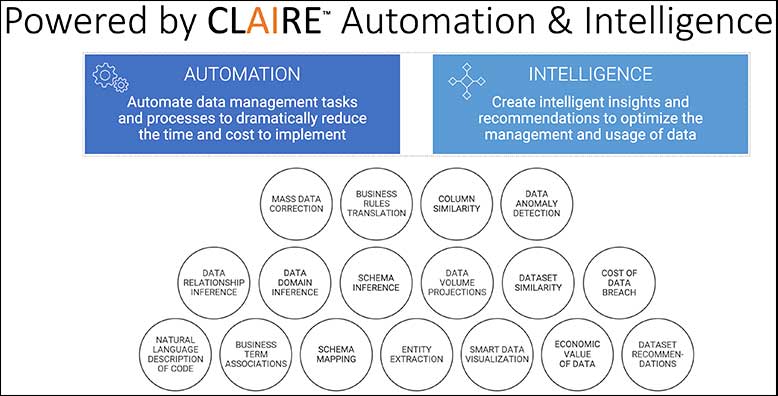
4. Data preparation and data delivery. Enterprise Data Preparation makes it easy to simplify and speed up data preparation.
- Discover, explore, prepare, integrate, publish, visualize and share data. Use this intelligence to collaborate and operationalize in a single environment.
- Includes Excel-like interface with hundreds of pre-built data quality rules. Use these to blend, transform, cleanse, shape and enrich the data.
- Enables precise control of user data access privileges for data preparation activities.
- Delivers intelligent recommendations such as alternate data assets, next-best action and more.
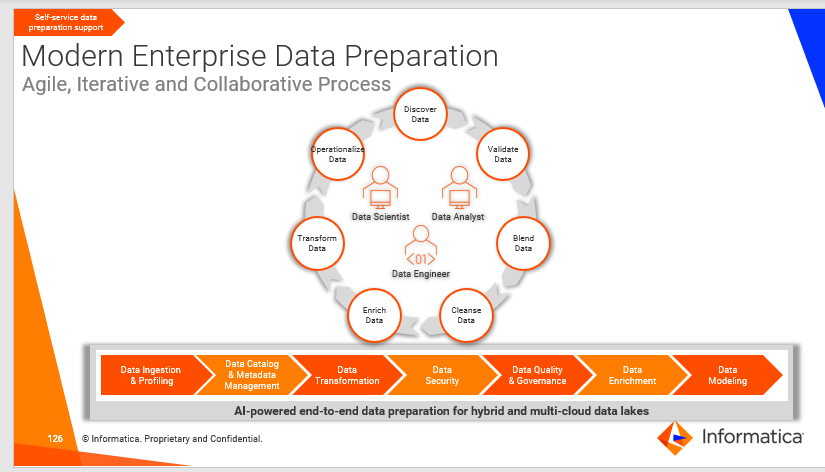
5. Orchestration and DataOps. Gain understanding of all data delivery flows with Enterprise orchestration and XOps capabilities. Support continuous analysis and monitoring with DataOps, MLOps and InfosecOps.
- Enables end-to-end CI/CD approach with DataOps, MLOps and InfoSecOps capabilities.
- Automates tasks in the data lifecycle, and auto-scale, self-tune, self-heal and self-secure.
- Maximize reusability and auto-generation of data pipelines. Reduce test cases by 100x with metadata-driven and dynamic template approach.
- Delivers intelligent operational insights for continuous observation and improvement.
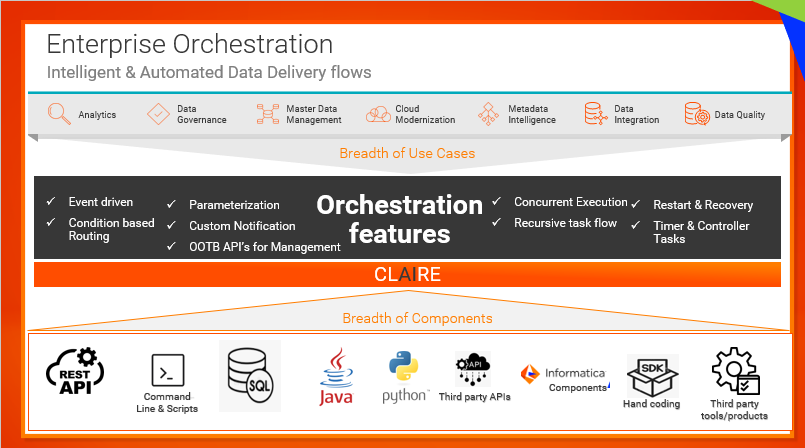
Informatica data fabric benefits
Expedites time to value with industry-leading active metadata and intelligent data management.
Optimizes costs while maintaining elasticity. Flexible consumption-based pricing lets you scale and leverage capabilities to meet your needs.
Facilitates data-driven decision-making. Automated data governance and privacy enforces compliance across all data. Increases transparency and collaboration while reducing compliance risks.
Supports multi-cloud, hybrid environments. Run, interoperate and support any combination of cloud and hybrid infrastructures.
Data fabric case study
BMC transforms complex technology into extraordinary business performance with a data fabric.
BMC software (BMC) helps companies around the world improve how they deliver and consume digital services. For their accounts payable and generic ledger operations, BMC had been using decentralized, manual processes. This caused a lack of standardization across countries and affected the BMC treasury team’s ability to see current account balances. As a result, BMC had to maintain excessive cash reserves to cover any unpredicted cash needs.
Working with Informatica, BMC was able to rapidly build a functional system. They then added more sophisticated capabilities for improved visibility into actual and projected cash flows. This allowed BMC to right size their cash position and optimize use of their working capital.
BMC saved hundreds of thousands of dollars, and now has much better reporting and control across hundreds of bank accounts. Accurate visibility into their holdings has allowed improved risk management and mitigation strategies.
The transformative next step is data fabric
Data fabric is the transformative next step for your enterprise. With a data fabric, you can automate data management in a hybrid, multi-cloud data landscape. Enable faster time-to-value for business users, increase productivity for data engineering, provide greater efficiency for operations and deliver robust governance and compliance.
Get started with an intelligent data fabric to accelerate your AI initiatives
Visit our Intelligent Data Management Cloud page to learn how you can accelerate your AI initiatives with a data fabric.
1The Forrester Wave™: Enterprise Data Fabric, Q2 2022: The 15 Providers That Matter Most and How They Stack Up. Noel Yuhanna with Aaron Katz, Angela Lozada, and Kate Pierpont, June 23, 2022/p>




